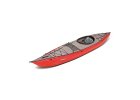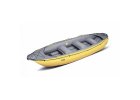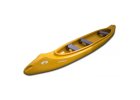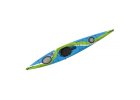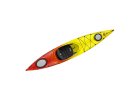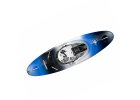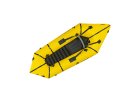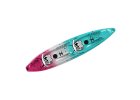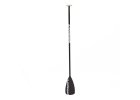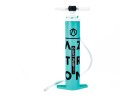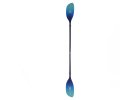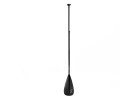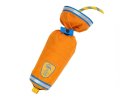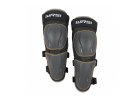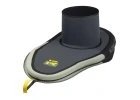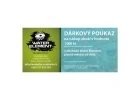Product detailed description
Bonusy v ceně:
- Dárkový poukaz na 6 000 Kč (240 EUR): Lze využít na libovolné vybavení z našeho e-shopu (platnost 12 měsíců).
- 2x triko Coolmax v hodnotě 1 792 Kč (72 EUR): Funkční trika pro pohodlné vodácké zážitky.
- Obal na mobil: Ochrání vaše zařízení před vodou během plavby.
Princess of Two Worlds
The True Story of Marie Eleonora of Liechtenstein, Lady of Moravian Krumlov
Introduction: the resolution of the two Eleonors and the revelation of true power
In the annals of Czech and Moravian nobility of the 18th century, the name "Princess Eleonora" shines with a double, often confused lustre. The first,Eleonora Amalie of Schwarzenberg, is indelibly linked with the majestic Český Krumlov in southern Bohemia. Her life story, marked by the tragic death of her husband and her own painful death from cancer, became the bizarre and unfair basis for the unfounded but popular vampire legends that fascinate to this day.
This chapter, however, is devoted to a second, no less fascinating and historically perhaps even more influential woman:Maria Eleonora of Liechtenstein. Her name and legacy are carved in stone and inscribed in the landscapeMoravian Krumlov, but its influence extended far beyond the borders of the Moravian dominion. She shone like a comet in the political skies of imperial Vienna, where she became one of the most powerful figures of her time.
She was a woman who embodied the spirit of the Enlightenment in its most complex form. As the wife of the PrinceCharles of Bohemia of Liechtenstein became a co-founder of the Moravian-Krumlov branch of this powerful family. However, she was much more than just the obedient wife of a prominent nobleman. She was a key player on the chessboard of power, navigating the treacherous waters of court intrigue with grace and strategic genius. Her Viennese salon became the unofficial centre of power, her friendship with the EmperorJoseph II. gave her an unprecedented influence and her vision transformed the Moravian estate into an example of the most modern aesthetic and philosophical ideals. This is her story - a story of beauty, intelligence, ambition and power in the hands of a woman at a time when Europe was on the cusp of dramatic change.
Part I: The formative years of an imperial princess (1745-1761)
A noble origin and the shadow of tragedy
Fate began to write Maria Eleonora's story on 7 July 1745 in Oettingen, Bavaria, in the heart of an ancient and influential princely family. Her father was Johann Aloys I, Prince of Oettingen-Spielberg, and her mother was Princess Therese of Schleswig-Holstein-Sonderburg-Wiesenburg. However, the joy of the birth of a daughter was immediately overshadowed by the deepest tragedy; the mother died from the consequences of childbirth. This event cast a shadow over the childhood of the little princess that would shape her throughout her life. She grew up without a mother's embrace, which probably led to the formation of an extremely strong, almost inseparable bond with her four years older sisterMaria Leopoldina.
Education for the European scene
The absence of a mother was compensated by an education that far exceeded the contemporary standard for young noblewomen. At an early age, in 1749, she was sent with her older sister to be educated in a prestigious French convent in Strasbourg. It was not just a school of piety; it was an elite institution that shaped the minds of future European ladies. Here, she not only learned perfect French, the language of diplomacy and culture, but also penetrated the secrets of literature, philosophy, music and the art of sophisticated conversation. She was trained in logic and critical thinking, which gave her a great advantage in later debates in the Viennese salons.
Financial independence and court debut
At the age of 15, a turning point came that changed her life forever. She inherited extensive estates in Bohemia from her aunt, including the Velké Meziříčí estate (1764-1812). This inheritance not only made her a wealthy bride, but gave her financial independence - a powerful tool that was quite exceptional for a woman of her age and status. She could make her own decisions, investments and plans. Shortly afterwards, she and her sister were introduced to the imperial court in Vienna, where Empress Maria Theresa chose her as her lady-in-waiting. The Viennese court was a vibrant centre of power, the highest school of politics and diplomacy, where Eleonora learned to read between the lines, understand ulterior motives and navigate the labyrinth of power relations with a keenness all her own.
Part II: The Husband: the Warrior Prince Charles of Bohemia
Strategic alliance and diplomatic game
Life at court was subject to a strict protocol, which also applied to marriages arranged by the Empress. Marie Eleonora was originally betrothed to Prince John Nepomuk of Schwarzenberg. However, this plan was thwarted by an influential diplomat and field marshal, Prince Joseph Wenceslaus of Liechtenstein, who pushed for the marriage of the charming and intelligent princess to his nephew,Charles of Bohemia of Liechtenstein. The wedding took place on 30 March 1761 in Vienna and for Maria Eleonora it marked the definitive consolidation of her position in the highest circles of the monarchy. This marriage combined Charles's military fame with Eleonora's intellect, huge dowry and political connections.
A soldier in body and soul
Prince Charles of Bohemia (1730-1789) was the embodiment of the ideal of the aristocratic soldier. As the second-born son of Prince Emmanuel of Liechtenstein, he was destined for a military career and joined the army as early as 1747. His star shone brightly during the Seven Years' War, where he distinguished himself as a cavalry commander at the Battle of Liberec (1757) and at the capture of Svídnice. His career rose steeply: in 1760 he attained the rank of field marshal and after the war he became inspector general of cavalry. He reached his peak in 1772, when he received the most prestigious Habsburg decoration, the Order of the Golden Fleece, and was promoted to field marshal in 1788. Together with his wife, he was one of the close friends of Emperor Joseph II and became the founder of the Moravian Krumlov Secondary Family, which was based at the Moravian Krumlov Castle from 1772. He died in Vienna in February 1789 and was buried in the newly established family tomb in Moravské Krumlov.
Part III: Family and Descendants: The Founding of Moravian Secondogeniture
The marriage of Maria Eleonora and Charles of Bohemia was blessed with seven children. Together they founded the so-called Charles line (secondary line) of the Liechtenstein family, which chose the castle in Moravské Krumlov as its seat. Their descendants became important soldiers and successors of the family, whose life paths mirror the duties, glory and tragedies of the aristocracy of the time.
| Name | Birth-Death | Achievements and destiny |
|---|---|---|
| Marie Josefa | 1763-1833 | She married Jan Nepomuk Arnost of Harrach. Her childless marriage was a typical dynastic union of two important families. |
| Karel Jan | 1765-1795 | A promising heir to an estate. However, his life was prematurely extinguished at the age of 30 when he was killed in a duel over a dispute over his wife. A tragedy that shook the family. |
| Josef Václav František | 1767-1842 | Originally destined for an ecclesiastical career as a canon in Salzburg, he eventually followed the family tradition and became a major general. He died childless. |
| Emanuel Kašpar | 1770-1773 | His short life is a sad reminder of the high infant mortality rate, which did not escape even the wealthiest families. |
| Moric Josef | 1775-1819 | The ablest of military sons. As a field marshal, he made his name in the Napoleonic Wars. His marriage to Maria Leopoldina Esterházy ensured the continuation of the family line. |
| František Alois | 1776-1794 | A young and brave governor who fell at the age of only 18 fighting against revolutionary France in Ypres, Belgium. His death is a testament to the military sacrifices expected of the nobility. |
| Alois Gonzaga | 1780-1833 | Another great warrior who reached the rank of field armorer. As a Knight of the Order of the Golden Fleece, he was one of the highest military elite. |
Part IV: Visions in Stone and Soil: The Trail in Moravské Krumlov
As soon as Marie Eleonora became the mistress of Moravské Krumlov, she set about transforming the somewhat outdated mansion into a modern and representative centre with her own energy. Her vision was comprehensive and touched every aspect of castle life. It was not just a cosmetic makeover; it was a manifestation of her taste, intellect and status. She had the castle landscaped, the old moats filled in and the chapel opened to the public.
English Park as an ideological manifesto
The most daring and progressive undertaking was the creation of a large English park in front of the castle. At a time when European gardens were still dominated by the strict geometry and symmetry of the French Baroque style, symbolising the absolute power of man over nature, the English park was a revolutionary step. It was inspired by idealised landscape paintings and Enlightenment ideas of a return to nature. The park was intended to be a wild but carefully composed landscape, full of meandering streams, romantic nooks and crannies, picturesque vistas and exotic trees. It was a celebration of freedom, reason and emotion.
Patronage and Enlightenment Philanthropy
Her influence was not limited to aesthetics. In the spirit of Enlightenment charity (*beneficence*), she also tried to be a good mistress to her subjects. Not only did she open the castle chapel, symbolically lowering the barrier between the nobility and the people, but her magnificent building projects also provided work and livelihood for dozens of local craftsmen and workers, contributing to the prosperity of the whole estate.
Part V: The Crown of the Dynasty: the Liechtenstein Tomb
Manifestation of power and eternity
In 1789, the year her husband Charles of Bohemia died, Marie Eleonora made her most powerful symbolic gesture. She had a magnificent family tomb built at the parish church of All Saints in a strict classical style. This act was a declaration of the independence, permanence and importance of the Moravian-Krumlov branch she founded. By building her own mausoleum, she made it clear that her line was a separate and fully-fledged dynasty, independent of the main branch of the family, which had its burial place in Vranov u Brna. With this act, she carved her family's legacy in stone for future generations.
The work of the Viennese masters
The tomb is considered one of the first purely classicist buildings of its kind in the Czech lands. For its design, the princess chose a renowned Viennese architectJohann Henrizziwho created a building inspired by ancient temples, with clean lines and an elegant columned facade. The façade bears a Latin inscription dedicated to the memory of her husband and the German inscription "Lord, be not our judge but our saviour". On the sides of the entrance are the stone coats of arms of the Liechtenstein and Oettingen-Spielberg families. The interior of the chapel is dominated by an altarpiece of the Crucified by another top painterHubert Maurerprofessor and rector of the Vienna Academy. A total of 21 members of the family, including Marie Eleonora and her husband, were buried in the underground crypt between 1789 and 1908.
Part VI: The Vienna Arena: Power, Politics and Imperial Friendship
the "Circle of Five Priestesses": an unofficial power centre
While her summers were spent building her Moravian mansion, the winters belonged to vibrant Vienna. There, Marie Eleonora became the uncrowned queen of social and political life. Her salon, known as the "Circle of Five Princesses", became legendary. It was no place for idle talk and superficial entertainment. It was an arena where top politics were discussed over cards and tea, alliances were formed and key decisions were made. The Emperor himself often attended these meetings in the Hofburg or Schönbrunn.
Dangerous Game: the Emperor and his confidante
The axis of her influence was her extremely complex and close relationship with the EmperorJoseph II. After the death of his mother Maria Theresa, the widowed and emotionally deprived monarch fell deeply in love with the beautiful, intelligent and witty princess. He asked her to become his official mistress, which would have placed her in the role of the most powerful woman at court. Maria Eleonora, disturbed by this situation, travelled to Krumlov. Although the emperor sent her love letters, she showed brilliant strategic judgment and tactfully refused him. She knew that the position of a mistress was fickle and subject to whim. Instead, she was able to turn his passion into something far more valuable: a deep, lifelong friendship and political partnership. She became his only true confidante, mentor and fearless critic. This masterstroke ensured her lasting and incomparably greater influence.
Part VII: The Private Woman Behind the Public Facade
Behind the façade of a powerful politician and patron was a woman full of passion. In the 1860s she had a recorded love affair with the charismatic Irish cavalry general, Earl Charles O'Donnell. This relationship was not a scandal in Viennese society, but rather an accepted social fact. Among her favourite pastimes were strategic card games like quadrille, which were not only entertainment but also a ritual of power and conversation. She loved music, the theatre, hunting and horse-riding, which were typical pastimes of the aristocracy, but to which she added a touch of elegance and intellect.
Part VIII: Legacy, Descendants and the Immortal Bloodline
The End of an Era: The Demise of the Moravian-Krumlov Branch
The story of the Moravian-Krumlov branch, which Marie Eleonora so magnificently built, came to a close at the beginning of the 20th century, in a world that was already dramatically different from hers. The last male descendant was her great-grandson, PrinceRudolf of Liechtenstein (1838-1908). He was a man of the old school, a distinguished courtier and supreme Hofmeister to Emperor Franz Joseph I. He lived a life of devoted service to the monarchy, but never married and had no children. With his death in 1908, the famous Moravian-Krumlov branch of the sword died out and he was the last person buried in the local tomb. Thus extinguished the direct male line established almost 150 years ago by the ambitious princess.
Immortal legacy after the crossed line: the Schwarzenberg line
Although the name of the Krumlov Lichtenstein family has disappeared, the blood and legacy of Marie Eleonora lived on. Her bloodline continued by descent through her son Moritz and his daughter Eleonora Maria. The latter married Prince Ferdinand of Schwarzenberg and this marriage symbolically linked the fates of the two Krumlovs - Moravian and Czech. The blood of the visionary princess was thus poured into the veins of one of the most important Czech families. A direct descendant in this line was the recently deceasedKarel Schwarzenberg (1937-2023). The successor of the family and the current head of the Schwarzenberg branch in Orlice is today his sonJohn Nepomuk III. Schwarzenberg. He and his family are thus a living legacy that links Marie Eleonora's Enlightenment era with the present.
Encyclopedia of people and places
Marie Eleonora of Liechtenstein
(1745-1812)
Marie Eleonora was not just a passive product of her time; she was an active co-creator. Her personality was a fascinating blend of aristocratic grace, keen intellect and unwavering will. The education she received at the convent in Strasbourg was not only about etiquette and French. It was a deep study of philosophy, history and rhetoric that enabled her not only to lead but also to dominate the intellectual debates in her famous Viennese salon. She was a conversation partner for the greatest minds of her time, including the emperor himself.
Her political influence was palpable. She was not afraid to openly oppose the emperor's most radical ecclesiastical reforms, which she considered too hasty and destructive of the traditional order. Her criticisms, however, were always delivered with such tact and intelligence that she never lost the emperor's confidence. Her salon became an informal institution, a kind of "shadow government", where matters of state were discussed before they reached official proceedings. It was here that the careers of ministers and generals were decided and foreign policy was shaped. She was a well-known opponent of Minister Thugut and later of the rising star, Clemens von Metternich, whose policy of marrying Archduchess Marie-Louise to Napoleon she considered a national humiliation. Her influence stemmed from a combination of personal charm, extensive family connections and, above all, her position as an independent and respected advisor to the Emperor.
Eleonora Amalie of Schwarzenberg
(1682-1741)
The life story of the lady at Český Krumlov is a drama worthy of Shakespeare. Her husband, the PrinceAdam Frantisek of Schwarzenberghe was an avid hunter, which proved fatal to him. In 1732 he participated in an imperial hunt near Brandýs nad Labem. In the heat of the hunt, he came into the firing line of the Emperor himselfCharles VI.who accidentally fatally shot him. The Emperor was devastated by this tragedy. He immediately took charge of his orphaned son Joseph Adam and took over the patronage of the family. Eleonora, now a widow, became regent and proved to be an extremely capable and energetic administrator of the vast estate.
Her last years were marked by a battle with cancer. She underwent exhausting and painful treatment, which included unusual and expensive remedies for the time, such as drinking wolf's milk. Her illness and the associated physical changes, together with her penchant for mysticism, fed the imagination of her subjects. After her death in 1741, an autopsy was performed to determine the cause of death - a highly unusual step for a high-ranking noblewoman at the time. The autopsy report describing her diseased body was found decades later and misinterpreted in the atmosphere of anti-Venus hysteria that spread through Europe. Thus was born the legend of the "vampire priestess", a fascinating, if entirely fictional, testament to how fear and superstition can distort historical reality.
Moravský Krumlov Castle
The castle in Moravský Krumlov, majestically towering on a rocky promontory above the meanders of the Rokytná River, is a true chronicle of history. Its story begins as early as 1146, when it was the site of a fortress and later the county castle of Rokiten, a strategic guardian of trade routes. After its destruction during the disputes between the Přemyslids, a new stone castle was built and named Krumlov. Over the centuries, important families such as the lords of Obřany, Kravař and Cimburk have changed here, each of them leaving their mark on the castle. However, it was not until the 16th century that the Lords of Lipá made the final transformation into a Renaissance jewel. According to the designs of the Italian builderLeonarda Gara de Bisono an elegant four-winged building with a magnificent arcaded courtyard decorated with coats of arms and reliefs was built in 1557-1562.
After the Battle of White Mountain, the Liechtensteins acquired the manor. They continued to modify the castle, but the most significant trace was left by Marie Eleonora and her husband, who lived here since 1772. After the extinction of their line, the castle passed to the related Kinský family. The dramatic 20th century brought the bombing of the town by the Red Army at the end of the Second World War, which the castle miraculously survived. After the war, it was confiscated and used as a seat of offices and later as a school, which led to its gradual decay. After 1989 it went through a difficult period of privatisation and further decline. The turning point came in 2016, when the town of Moravský Krumlov managed to acquire the castle into its ownership. Thanks to a huge effort, extensive reconstruction began in 2020, which returned the castle to its former glory. Since the summer of 2022, it has been open to the public again and, in addition to the exhibitionSlavic epics offers tours of the repaired interiors and a climb to the castle tower.
Charles of Bohemia of Liechtenstein
(1730-1789)
Prince Charles Borromeo Joseph of Liechtenstein was the embodiment of the ideal of the aristocratic soldier of the Theresian era. As the second-born son, he was destined for a military career, while his older brother Franz Joseph I inherited the title of reigning Prince of Liechtenstein. He threw himself into military service with vigour and soon earned a reputation as a brave and talented cavalry commander. His star shone brightly during the Seven Years' War (1756-1763), where he distinguished himself at the Battle of Cologne (1757) and the Battle of Liberec. His career ascended, culminating in his attainment of the highest military rank of field marshal (1788) and the award of the most prestigious Habsburg decoration, the Order of the Golden Fleece, in 1772.
His marriage to Maria Eleonora was crucial for him. Her enormous dowry and influence at court gave him the means and prestige to found his own Moravian-Krumlov branch of the family - the Secondary Genealogy, whose seat became Moravský Krumlov in 1772. This step enabled him to become the lord of his own estate and to secure the future for his descendants. Together with Marie Eleonora, they formed a strong and ambitious couple, where military glory was combined with political influence and cultural patronage.
Liechtenstein Tomb in Moravské Krumlov
The construction of the family tomb in 1789 was the crowning of Marie Eleonora's life's work and a manifestation of the importance of her family. It is a perfect exampleclassicism and one of the first buildings of this type in Moravia. For the design, the princess chose a renowned Viennese architectJohann Henrizziwho created a building with strict, clean lines, evoking the impression of an ancient temple. The coats of arms of the Liechtenstein and Oettingen-Spielberg families and a Latin inscription commemorating the foundation of the tomb are on the facade.
For the interior decoration, specifically for the altarpiece of the Crucified, she engaged another top personality - the painterHubert Maurer, rector of the Vienna Academy of Fine Arts. By creating her own mausoleum, Marie Eleonora made it clear that her Moravian-Krumlov branch was a separate and fully-fledged dynasty, independent of the main line of the family buried in Vranov u Brna. Between 1789 and 1908, 21 members of the family were laid to eternal rest in the tomb.
Emperor Joseph II.
(1741-1790)
The son and successor of Maria Theresa, Joseph II was one of the most controversial and fascinating figures in European history. He was the prototype of the Enlightenment absolutist - a monarch who believed it was his duty to rule by reason and to bring prosperity to his subjects, even against their will. His motto was "Everything for the people, nothing through the people". During his relatively short independent reign (1780-1790), he attempted to radically transform the entire Habsburg monarchy. He issued more than 6,000 decrees and regulations in an attempt to modernise and centralise the civil service, simplify the legal system and limit the power of the Church. Among his most famous and enduring reforms areabolition of serfdom (1781), which gave the peasants personal liberty, andTolerance patent (1781), which guaranteed limited religious freedom for Lutherans, Calvinists and Orthodox.
His personal life was marked by tragedy. He loved his first wife, Isabella of Parma, deeply and passionately, but she died of smallpox after several years of marriage. He never showed any affection for his second wife, Maria Josepha of Bavaria, whom he married for purely political reasons. After her death, he never remarried and remained emotionally lonely. This emptiness in his life may explain his deep and intense attachment to Maria Eleonora, with whom he fell in love after the death of his mother. In her he found not only an intelligent partner for political debate, but also a kindred spirit and an understanding friend to whom he could confide his doubts and worries.
Marie Leopoldina von Kaunitz
(1741-1795)
The older sister of Marie Eleonora, with whom she shared an exceptionally strong bond, formed by a common childhood without a mother and her upbringing in a convent. She was her closest confidante and ally throughout her life. While Eleonora was renowned for her strategic thinking and diplomatic tact, Leopoldina was known for her directness, energy and sometimes fiery temperament. Together, they formed the perfect team to dominate Viennese society.
Her importance was further increased by her marriage to the EarlErnst Christoph von Kaunitz-Rietberg. This made her the daughter-in-law of one of the most powerful men in the monarchy, the Chancellor of StateVáclav Antonín, Prince of Kounic-Rietberg. For almost forty years this man directed the foreign policy of the Habsburg Empire and was a key figure in European diplomacy. Thanks to this family connection, the sisters had access to the most confidential information and could influence events not only through the Emperor but also through the highest circles of the state administration. Leopoldina was a key and very vocal member of the "Circle of Five Priestesses". Her sharp and well-articulated opinions, for example on the American Revolution, were often heard in the salon and demonstrate that there were debates at the highest intellectual and political level that affected the entire world at the time.
Karel Schwarzenberg
(1937-2023)
His princely clarity Karel Schwarzenberg was a fascinating figure who linked the deep history of European nobility with modern Czech and European politics. As the head of the Eagle branch of the Schwarzenberg family, he was a direct descendant of Maria Eleonora of Liechtenstein, specifically her great-great-great-grandson. This connection was not just a genealogical curiosity; his personality reflected part of the legacy of his famous ancestress - cosmopolitanism, intellectual insight and a deep sense of service to the state.
After the communist coup in 1948, his family was forced to go into exile in Austria. There he became actively involved in supporting Czechoslovak dissent and became chairman of the International Helsinki Committee for Human Rights. After the Velvet Revolution in 1989, he immediately returned to his homeland and offered his services to the fledgling democracy. President Václav Havel chose him as his chancellor and Karel Schwarzenberg became one of the key figures of the post-Soviet development. He later served as a senator, deputy and twice as the Czech Foreign Minister, where he put his lifelong experience and contacts to good use. In 2013, he reached the second round of the direct presidential election. His existence and public service are living proof of how a bloodline and its associated values can endure for centuries, and how the legacy of a visionary 18th-century princess could resonate in 21st-century politics.
John Nepomuk III. Schwarzenberg
(* 1967)
Jan Nepomuk III, full name Jan Nepomuk Ondřej Jindřich Josef Karel Ferdinand Jan Evangelista Three Kings Achaz, Prince of Schwarzenberg, is the current head of the Eagle branch of the family and a direct descendant of Marie Eleonora of Liechtenstein. After the death of his father, Karl Schwarzenberg, in 2023, he became his successor and heir. Although, unlike his father, he is not involved in active politics, his role is key to the preservation and management of the extensive family heritage, which includes forests, ponds, farmland and historic properties such as Orlik Castle and Zvíkov Castle.
He grew up mostly in exile in Austria and Germany, where he studied forestry, which prepared him perfectly for his current role as manager of the family estate. After 1989, he returned to Czechoslovakia with his father and began to participate in the restoration and management of the returned estates. He is known as a modern farmer who emphasises sustainability and an ecological approach. With his wife, the writer and designer Alžbeta, née Pezoldová, he continues the family tradition of cultural patronage and care for historical heritage. His figure represents a bridge between the centuries-old tradition of the noble family and the challenges of the 21st century, and is thus living proof of the enduring legacy of his great-great-great-grandmother, Marie Eleonora.
Slavic Epic
The Slavonic Epic is a monumental cycle of twenty large-format paintings by the Czech painterAlphonse Muchawhich is considered his life's work. Mucha worked on it between 1910 and 1928 and depicted key moments in the mythology and history of the Czechs and other Slavic peoples. The paintings are not just historical scenes; they are imbued with symbolism, patriotism and a belief in the spiritual mission of the Slavs. Their dimensions are staggering, some reaching up to 6x8 metres.
The cycle was first exhibited in its complete form in 1928 at the Trade Fair Palace in Prague. Alfons Mucha donated the entire work to the Czech nation and to Prague on the condition that the city would build its own separate exhibition pavilion for it. This promise was never fulfilled. After the Second World War, the paintings were stored and in 1963 they were transported to the Moravský Krumlov Chateau, where they were exhibited for almost fifty years and became a symbol of the town. In 2012, the epic was transported back to Prague, sparking a wave of controversy. After years of controversy, it is now back in Moravské Krumlov, where it is on display for the public.
Adam Frantisek of Schwarzenberg
(1680-1732)
The Duke of Schwarzenberg and Duke of Krumlov, Adam František was an important figure of the Baroque nobility and a capable farmer. He was known for his passion for hunting, which unfortunately proved fatal. As High Court Marshal, he was responsible for organising the imperial hunts and was a close companion of Emperor Charles VI. It was during one such hunt in 1732 that tragedy struck. The Emperor, who was shooting at a deer, hit the Prince, who accidentally found himself in the path of the shot. The prince died of his wounds. Emperor Charles VI was devastated by the event and felt deep personal guilt. To atone for his actions, he assumed personal guardianship over the widow Eleonora Amalia and their son Joseph Adam, ensuring their protection and the support of the court. Ironically, this tragedy further strengthened the Schwarzenbergs' position at the imperial court, but left a deep scar on the family history.
Emperor Charles VI.
(1685-1740)
Emperor of the Holy Roman Empire and ruler of the Habsburg lands, Charles VI was the last male descendant of the Habsburg dynasty. His reign was defined by one main goal: to ensure that his eldest daughter, Maria Theresa, could succeed him on the throne. Because traditional succession laws favored men, he had to enforce a new law known as thePragmatic sanction. This document of 1713 established the indivisibility of the Habsburg lands and allowed for succession in the female line. His entire foreign policy was subordinated to the effort to have this document recognised by all European powers. Although he succeeded diplomatically, after his death in 1740 wars immediately broke out over the Austrian succession, which the young Maria Theresa had to fight hard to win. Charles VI was also a great lover of music and art, but his legacy is inextricably linked to the struggle for the future of his daughter and the dynasty.
Ernst Christoph von Kaunitz-Rietberg
(1737-1797)
Count Ernst Christoph was a prominent Austrian diplomat and courtier, whose position was further enhanced by the fact that he was the nephew and protégé of the all-powerful Chancellor of State Václav Antonín of Kounice. He served as ambassador in Naples and later held high positions at court. His marriage to Maria Leopoldina of Oettingen-Spielberg was a strategic union of two influential families. For Leopoldina and her sister Maria Eleonora, it meant direct access to the highest levels of Austrian politics and diplomacy. Ernst Christoph became part of their social circle and his connections and information were invaluable to the political ambitions of both sisters. Although he stood in the shadow of his more famous uncle, he was an important link between the salon priests and the official structures of state power.
Václav Antonín of Kounic-Rietberg
(1711-1794)
Prince Václav Antonín of Kounic-Rietberg was one of the greatest statesmen and diplomats of the 18th century. For almost forty years, from 1753 to 1792, he was at the forefront of Habsburg foreign policy as Chancellor of State. His influence during the reigns of Maria Theresa and Joseph II was enormous and he was nicknamed the "coachman of Europe". His greatest diplomatic achievement was the so-called "Great War"."reversal of alliances" before the Seven Years' War, when he succeeded in ending centuries of hostility between the Habsburgs and France and forged a new alliance against a rising Prussia. He was a master of backroom dealings, an intelligent and learned man, but also notorious for his arrogance and vanity. The family connection to this man, through the marriage of his nephew to Marie Leopoldine, gave the sisters Eleonora and Leopoldine access to information and leverage of power undreamed of by most nobles. No doubt his views and strategies were often discussed in their salon.
Johann Henrizzi
Viennese architect who was one of the most important representatives of early classicism in the Habsburg monarchy. His style was characterised by a departure from the ornate and curvaceous style of the late Baroque and Rococo periods and a move towards simplicity, symmetry and monumentality inspired by ancient architecture. His buildings, often palaces and public buildings, emphasised purity of form, geometric precision and elegant proportions. That Marie Eleonora chose him to design such a personal and symbolic project as the family tomb is testament to her progressive taste and desire to be at the cutting edge of modern artistic movements. She wanted to create a memorial for her family that was not just a tomb, but a timeless work of art, and Henrizzi's classical style was perfectly suited for this purpose.
Hubert Maurer
(1738-1818)
Hubert Maurer was a respected Austrian painter and teacher who became a key figure in Viennese academic art at the turn of the 18th and 19th centuries. He studied and later himself served as professor and rector at the prestigious Vienna Academy of Fine Arts. His work is a typical example of classicism - characterised by precise drawing, clear and balanced composition, and subjects often drawn from history, mythology and religion. His style was in stark contrast to the playfulness and decorativeness of Rococo. By entrusting him with the creation of the altarpiece for the family tomb, Marie Eleonora made her artistic preferences clear. She did not want a sentimental or ornate scene, but a dignified, academically accomplished work that would match the solemnity and monumentality of the tomb's classical architecture. Her choice confirms her role as an educated and discerning patron.
Alfons Mucha
(1860-1939)
Czech painter, graphic artist and designer who became one of the most important personalities of the European Art Nouveau, known in France as Art Nouveau. He was born in Ivančice, near Moravský Krumlov. He gained worldwide fame in Paris at the end of the 19th century, mainly thanks to his theatre posters for the legendary actress Sarah Bernhardt. His style - characterised by elegant lines, ornamental motifs and idealised female figures - defined an entire artistic epoch. Although he was celebrated as a master of the decorative arts, his heart yearned to create work with a deeper, patriotic message. Upon his return to his homeland, he devoted nearly twenty years of his life to the creation of his magnum opus, the Slavic Epic. With this cycle he wanted to raise the spirit and self-esteem of the Czech and other Slavic peoples and to recall their glorious history and mythology. His life's journey is a fascinating story of an artist who achieved worldwide success but ultimately returned to his roots to serve his nation.
Leonardo Garo de Bisono
Italian builder and architect who is one of the important artists who brought the authentic style of the Italian Renaissance to Moravia in the 16th century. These "Wallachian" masters were invited by wealthy noblemen who desired modern and representative mansions according to the latest trends from the Apennine Peninsula. Leonardo Garo de Bisono worked in the service of the powerful Lords of Lipé and his most important and best preserved work is the conversion of the originally Gothic castle in Moravské Krumlov into a splendid Renaissance chateau. He is the author of the magnificent arcaded courtyard, which is still the pride of the castle today. The three-storey arcades with elegant columns and relief decoration are a perfect example of Northern Italian Renaissance architecture and testify to his mastery and artistic flair.
Additional parameters
| Gumotex raft models: | Ontario 450S |
|---|---|
| Modely Gumotex rafty: | Ontario 450S |
You will find the product in this category
Why choose the Gumotex brand
As the largest Gumotex boat dealer in the Czech Republic and Slovakia, we know why our boats are so popular. Gumotex boasts a nearly 70-year tradition of manufacturing inflatable boats that are synonymous with quality and innovation. Each boat is made from premium materials with attention to detail and the environment, making it your reliable partner on every water adventure.
Reasons to choose Gumotex:
- Unique material and technology: Gumotex boats are not made from ordinary PVC, but from rubber - a natural material that provides excellent durability and flexibility. By producing our own materials, we have full control over the quality of the manufacturing process.
- Environmentally friendly manufacturing: We are committed to environmentally friendly manufacturing practices. Gumotex uses natural and synthetic rubber, minimizing the environmental impact compared to traditional PVC materials.
- Innovation and safety: All our boats are designed for maximum safety and comfort. The boats have a minimum of three air chambers, ensuring that even if one chamber is damaged, the boat will remain afloat.
- Practicality and comfort: Gumotex boats are designed to provide plenty of space and are easy to transport. Most models come in a waterproof backpack that makes the boat easy to carry and store.
- Customer service: We offer comprehensive warranty and post-warranty service, advice on choosing a boat and ensure the availability of spare parts even for models that are no longer standard.
A more detailed look at the production and materials of Gumotex
How Gumotex boats are made: Production starts with sourcing rubber that is environmentally friendly and easy to repair. This material is obtained by cutting the bark of the rubber tree, which is a sustainable resource. Our process is fully vertically integrated - from raw material to final product, ensuring the highest quality standards.
Materials used
We build boats from the ground up. Especially for them we have developed our own material based on natural rubber, which guarantees that the boats will last. They are resistant to abrasion, aging and sunlight.
NITRILON® + DROP-STITCH
- Material composition: Synthetic rubber based outer layer, anchor layer, high strength PES fabric (1,100 dTex), additional anchor layers and a top layer of drop-stitch fabric.
- Features: Minimum tensile strength 3 600/3 100 N (20 × 5 cm sample), minimum weight 1 270 g/m^2.
NITRILON®
- Material composition: High-strength PES fabric with an outer layer of synthetic rubber and an inner layer of natural rubber-based compound.
- Properties: Minimum tensile strength 3 000/3 000 N (20 × 5 cm sample), minimum weight 920 g/m^2.
NITRILON® double-sided
- Material composition: High-strength PES fabric with double-sided synthetic rubber coating.
- Properties: Minimum tensile strength 3 000/3 000 N (20 × 5 cm sample), minimum weight 1 192 g/m^2.
NITRILON® EXTRA
- Material composition: High-strength PES fabric with an inner layer of synthetic rubber and an outer layer of NITRILON® EXTRA.
- Features: Highest quality material for maximum load in professional use and for use in harsh climatic conditions. Minimum tensile strength 3,000/3,000 N (20 × 5cm sample), minimum weight 1,487g/m^2.
PES-PUR
- Material composition: PES fabric type RIPSTOP with internal polyurethane coating and Teflon treatment against water wetting.
- Properties: The material is abrasion, ageing and UV resistant. Minimum tensile strength 1100/900 N (20 × 5 cm sample).
These materials ensure that Gumotex boats provide exceptional durability and long life, which is why they are so popular with paddlers.
- All international orders are shipped via PPL carriers.
- After dispatching your order, we will send you an email with a tracking number.
If your delivery country is not listed here, please contact us. We will find the optimal shipping solution at the best price.
Shipping Costs via PPL
| Country | Shipping Cost (up to 20 kg) | Free Shipping from |
|---|---|---|
| Czech Republic | 99 CZK | 3,000 CZK |
| Belgium | 10.50 € | 200 € |
| Bulgaria | 15.50 € | 200 € |
| Croatia | 10.50 € | 200 € |
| Denmark | 10.50 € | 200 € |
| Estonia | 15.50 € | 200 € |
| Finland | 24 € | 200 € |
| France | 15.50 € | 200 € |
| Ireland | 24 € | 200 € |
| Italy | 15.50 € | 200 € |
| Lithuania | 15.50 € | 200 € |
| Latvia | 15.50 € | 200 € |
| Luxembourg | 10.50 € | 200 € |
| Hungary | 8.90 € | 200 € |
| Germany | 6.90 € | 200 € |
| Netherlands | 10.50 € | 200 € |
| Poland | 8.90 € | 200 € |
| Portugal | 24 € | 200 € |
| Austria | 6.90 € | 200 € |
| Romania | 15.50 € | 200 € |
| Greece | 29 € | 200 € |
| Slovakia | 6.50 € | 200 € |
| Slovenia | 15.50 € | 200 € |
| Spain | 24 € | 200 € |
| Sweden | 15.50 € | 200 € |
Paddle Shipping Costs
| Country | Shipping Cost | Free Shipping from |
|---|---|---|
| Czech Republic | 220 CZK | 5,000 CZK |
| Belgium | 19.90 € | 500 € |
| Bulgaria | 25.00 € | 500 € |
| Croatia | 19.90 € | 500 € |
| Denmark | 19.90 € | 500 € |
| Estonia | 19.90 € | 500 € |
| Finland | 29.00 € | 500 € |
| France | 25.00 € | 500 € |
| Ireland | 19.90 € | 500 € |
| Italy | 19.90 € | 500 € |
| Lithuania | 19.90 € | 500 € |
| Latvia | 19.90 € | 500 € |
| Luxembourg | 25.00 € | 500 € |
| Hungary | 19.90 € | 399 € |
| Germany | 19.90 € | 399 € |
| Netherlands | 19.90 € | 500 € |
| Poland | 19.90 € | 399 € |
| Portugal | 25.00 € | 500 € |
| Austria | 19.90 € | 399 € |
| Romania | 19.90 € | 500 € |
| Greece | 25.00 € | 500 € |
| Slovakia | 19.90 € | 399 € |
| Slovenia | 19.90 € | 500 € |
| Spain | 25.00 € | 500 € |
| Sweden | 29.00 € | 500 € |
|
If your delivery country is not listed here, please contact us. We will prepare a shipping cost calculation based on the destination. Select during shipping choice: Individual Shipping |
||
Kayak Shipping Costs
(length up to 300 cm)
| Country | Shipping Cost | Free Shipping from |
|---|---|---|
| Czech Republic | 20 € | Individual based on order value |
| Belgium | 59 € | 2,000 € |
| Bulgaria | 99 € | Individual based on order value |
| Croatia | 59 € | 2,000 € |
| Denmark | 59 € | 2,000 € |
| Estonia | 99 € | Individual based on order value |
| Finland | 119 € | Individual based on order value |
| France | 59 € | 2,000 € |
| Ireland | 119 € | Individual based on order value |
| Italy | 59 € | 2,000 € |
| Lithuania | 99 € | Individual based on order value |
| Latvia | 99 € | Individual based on order value |
| Luxembourg | 59 € | 2,000 € |
| Hungary | 39 € | 1,450 € |
| Germany | 39 € | 1,450 € |
| Netherlands | 59 € | 2,000 € |
| Poland | 39 € | 1,450 € |
| Portugal | 199 € | Individual based on order value |
| Austria | 19 € | 1,450 € |
| Romania | 99 € | Individual based on order value |
| Greece | 149 € | Individual based on order value |
| Slovakia | 19 € | 1,450 € |
| Slovenia | 39 € | 2,000 € |
| Spain | 199 € | Individual based on order value |
| Sweden | 149 € | Individual based on order value |
|
If your delivery country is not listed here, please contact us. We will prepare a shipping cost calculation based on the destination. Select during shipping choice: Individual Shipping |
||
Sea Kayak Shipping Costs
(length up to 500 cm)
| Country | Shipping Cost | Free Shipping from |
|---|---|---|
| Czech Republic | 59 €* | Individual based on order value |
| Belgium | 59 €* | Individual based on order value |
| Bulgaria | 59 €* | Individual based on order value |
| Croatia | 99 € | 3,000 € |
| Denmark | 59 €* | Individual based on order value |
| Estonia | 59 €* | Individual based on order value |
| Finland | 59 €* | Individual based on order value |
| France | 139 €* | Individual based on order value |
| Ireland | 59 €* | Individual based on order value |
| Italy | 119 € | 3,000 € |
| Lithuania | 59 €* | Individual based on order value |
| Latvia | 59 €* | Individual based on order value |
| Luxembourg | 59 €* | Individual based on order value |
| Hungary | 99 € | 3,000 € |
| Germany | 99 € | 3,000 € |
| Netherlands | 59 €* | Individual based on order value |
| Poland | 99 € | 3,000 € |
| Portugal | 59 €* | Individual based on order value |
| Austria | 99 € | 3,000 € |
| Romania | 59 €* | Individual based on order value |
| Greece | 59 €* | Individual based on order value |
| Slovakia | 89 € | 3,000 € |
| Slovenia | 119 € | 3,000 € |
| Spain | 59 €* | Individual based on order value |
| Sweden | 59 €* | Individual based on order value |
|
* The listed prices are minimum and may be increased or decreased based on the destination and order value. If your delivery country is not listed here, please contact us. We will prepare a shipping cost calculation based on the destination. Select during shipping choice: Individual Shipping |
||
Boat and Sea Kayak Shipping Costs
(length over 500 cm)
| Country | Shipping Cost | Free Shipping from |
|---|---|---|
| Czech Republic | 79 €* | Individual based on order value |
| Belgium | 79 €* | Individual based on order value |
| Bulgaria | 79 €* | Individual based on order value |
| Croatia | 79 €* | Individual based on order value |
| Denmark | 79 €* | Individual based on order value |
| Estonia | 79 €* | Individual based on order value |
| Finland | 79 €* | Individual based on order value |
| France | 79 €* | Individual based on order value |
| Ireland | 79 €* | Individual based on order value |
| Italy | 79 €* | Individual based on order value |
| Lithuania | 79 €* | Individual based on order value |
| Latvia | 79 €* | Individual based on order value |
| Luxembourg | 79 €* | Individual based on order value |
| Hungary | 79 €* | Individual based on order value |
| Germany | 79 €* | Individual based on order value |
| Netherlands | 79 €* | Individual based on order value |
| Poland | 79 €* | Individual based on order value |
| Portugal | 79 €* | Individual based on order value |
| Austria | 79 €* | Individual based on order value |
| Romania | 79 €* | Individual based on order value |
| Greece | 79 €* | Individual based on order value |
| Slovakia | 79 €* | Individual based on order value |
| Slovenia | 79 €* | Individual based on order value |
| Spain | 79 €* | Individual based on order value |
| Sweden | 79 €* | Individual based on order value |
|
* The listed prices are minimum and may be increased or decreased based on the destination and order value. The shipping cost will be determined individually based on the delivery address and type of boat. Select during shipping choice: Individual Shipping For an accurate calculation, contact us at info@kayak-shop.eu or by phone at +420737332592. |
||
Receipt and Claims
- Upon receiving the shipment, check the packaging. Report any obvious damage to the packaging immediately and note it in the transport protocol.
- A note can be added even with damaged packaging – any content defects can be claimed later. Please document the damage.
- Check the shipment contents after the driver leaves. Report hidden defects within 4 business days of receipt. Report obvious defects immediately and document them.
For availability verification or other inquiries, please contact us. We are happy to assist!
WATER ELEMENT – Kayak shop
Veslařská 26
624 00 Brno
Czech Republic
Phone: +420737332592
Email: info@kayak-shop.eu
Contact Us


